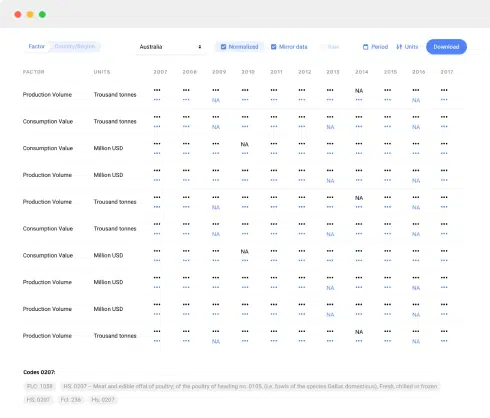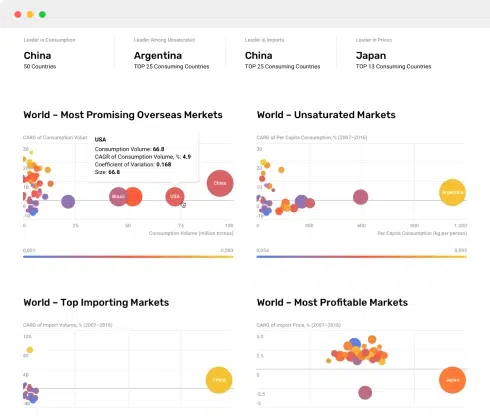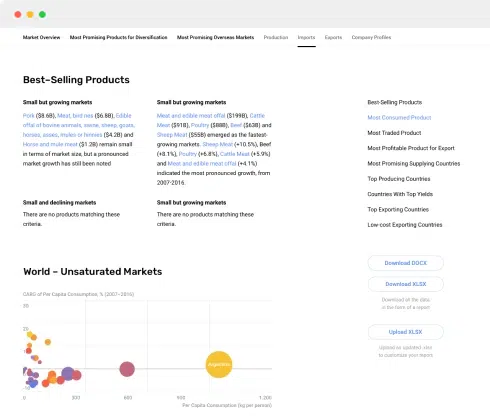
Lattafa Dominates with 22% Market Share, Versace and Yves Saint Laurent Command Premium Pricing at 56% Above Median
In today's hyper-competitive marketplace, understanding brand positioning is critical for strategic decision-making. This analysis leverages IndexBox data to dissect brand performance across key metrics—ratings, reviews, pricing, and sales volume—providing actionable insights for market leaders and challengers alike.
Methodology
The analysis aggregates marketplace data from IndexBox, focusing on five core visualizations: Rating vs Reviews, Price vs Sales Volume, Price Distribution, Market Share by Sales Volume, and Price Distribution by Top-5 Brands. Data is normalized by median values to highlight relative performance.
Rating vs Reviews: Segmenting Brands by Engagement
The scatter plot reveals four quadrants: Star Brands (e.g., Yves Saint Laurent, Versace) combine high ratings (4.35+) and reviews (120+), validating premium positioning. Rising Brands like Lattafa show high engagement but lower ratings (4.25), signaling room for quality improvements. Niche Brands (Gucci, Victorias Secret) excel in ratings but lack volume—ideal for targeted campaigns. Problematic Brands (MOBETTER FRAGRANCE OILS) underperform on both axes, necessitating product or marketing overhauls.
Price vs Sales Volume: Balancing Premium and Mass Appeal
Lattafa's low-price/high-volume strategy (454.9 units at $28.99) contrasts with Tom Ford's premium/low-volume approach (26.2 units at $214.59). Versace strikes a balance ($56.58, 180.5 units), suggesting optimal elasticity. Recommendations: Premium brands should expand mid-tier offerings; mass brands must guard against price erosion.
Price Distribution: Identifying Gaps and Opportunities
70% of products cluster below $53.47 (median), with a long tail to $335. Anomalies include a secondary peak at $99.83–$106.46, indicating untapped premium demand. Segment assortments into value (<$40), mid-tier ($40–$100), and luxury ($100+).
Market Share: Leadership and Portfolio Gaps
Lattafa leads with 22%, but the "Others" segment (24%) is fragmented—ripe for acquisition or disruption. Versace (7.4%) and Yves Saint Laurent (2.3%) should diversify into adjacent categories to capture more wallet share.
Price Dispersion: Optimizing Assortment Breadth
Yves Saint Laurent's wide range ($6.30–$209.99) risks brand dilution; tighten to $50–$150. MOBETTER FRAGRANCE OILS' flatlining at $11.99 suggests inflexibility—introduce tiered pricing.
Custom Search Request
IndexBox enables real-time parsing via the POST /api/brand/search API or dashboard. Save parameters (e.g., price filters, review thresholds) to automate competitive tracking.
Conclusion
Winners combine data-driven pricing (Versace), quality consistency (Yves Saint Laurent), and volume agility (Lattafa). Regular IndexBox monitoring is essential to adapt to market shifts.
1. INTRODUCTION
Making Data-Driven Decisions to Grow Your Business
- REPORT DESCRIPTION
- RESEARCH METHODOLOGY AND THE AI PLATFORM
- DATA-DRIVEN DECISIONS FOR YOUR BUSINESS
- GLOSSARY AND SPECIFIC TERMS
2. EXECUTIVE SUMMARY
A Quick Overview of Market Performance
- KEY FINDINGS
- MARKET TRENDSThis Chapter is Available Only for the Professional EditionPRO
3. MARKET OVERVIEW
Understanding the Current State of The Market and its Prospects
- MARKET SIZE: HISTORICAL DATA (2012–2024) AND FORECAST (2025–2035)
- MARKET STRUCTURE: HISTORICAL DATA (2012–2024) AND FORECAST (2025–2035)
- TRADE BALANCE: HISTORICAL DATA (2012–2024) AND FORECAST (2025–2035)
- PER CAPITA CONSUMPTION: HISTORICAL DATA (2012–2024) AND FORECAST (2025–2035)
- MARKET FORECAST TO 2035
4. MOST PROMISING PRODUCTS FOR DIVERSIFICATION
Finding New Products to Diversify Your Business
- TOP PRODUCTS TO DIVERSIFY YOUR BUSINESS
- BEST-SELLING PRODUCTS
- MOST CONSUMED PRODUCTS
- MOST TRADED PRODUCTS
- MOST PROFITABLE PRODUCTS FOR EXPORTS
5. MOST PROMISING SUPPLYING COUNTRIES
Choosing the Best Countries to Establish Your Sustainable Supply Chain
- TOP COUNTRIES TO SOURCE YOUR PRODUCT
- TOP PRODUCING COUNTRIES
- TOP EXPORTING COUNTRIES
- LOW-COST EXPORTING COUNTRIES
6. MOST PROMISING OVERSEAS MARKETS
Choosing the Best Countries to Boost Your Export
- TOP OVERSEAS MARKETS FOR EXPORTING YOUR PRODUCT
- TOP CONSUMING MARKETS
- UNSATURATED MARKETS
- TOP IMPORTING MARKETS
- MOST PROFITABLE MARKETS
7. PRODUCTION
The Latest Trends and Insights into The Industry
- PRODUCTION VOLUME AND VALUE: HISTORICAL DATA (2012–2024) AND FORECAST (2025–2035)
8. IMPORTS
The Largest Import Supplying Countries
- IMPORTS: HISTORICAL DATA (2012–2024) AND FORECAST (2025–2035)
- IMPORTS BY COUNTRY: HISTORICAL DATA (2012–2024)
- IMPORT PRICES BY COUNTRY: HISTORICAL DATA (2012–2024)
9. EXPORTS
The Largest Destinations for Exports
- EXPORTS: HISTORICAL DATA (2012–2024) AND FORECAST (2025–2035)
- EXPORTS BY COUNTRY: HISTORICAL DATA (2012–2024)
- EXPORT PRICES BY COUNTRY: HISTORICAL DATA (2012–2024)
10. PROFILES OF MAJOR PRODUCERS
The Largest Producers on The Market and Their Profiles
LIST OF TABLES
- Key Findings In 2024
- Market Volume, In Physical Terms: Historical Data (2012–2024) and Forecast (2025–2035)
- Market Value: Historical Data (2012–2024) and Forecast (2025–2035)
- Per Capita Consumption: Historical Data (2012–2024) and Forecast (2025–2035)
- Imports, In Physical Terms, By Country, 2012–2024
- Imports, In Value Terms, By Country, 2012–2024
- Import Prices, By Country, 2012–2024
- Exports, In Physical Terms, By Country, 2012–2024
- Exports, In Value Terms, By Country, 2012–2024
- Export Prices, By Country, 2012–2024
LIST OF FIGURES
- Market Volume, In Physical Terms: Historical Data (2012–2024) and Forecast (2025–2035)
- Market Value: Historical Data (2012–2024) and Forecast (2025–2035)
- Market Structure – Domestic Supply vs. Imports, in Physical Terms: Historical Data (2012–2024) and Forecast (2025–2035)
- Market Structure – Domestic Supply vs. Imports, in Value Terms: Historical Data (2012–2024) and Forecast (2025–2035)
- Trade Balance, In Physical Terms: Historical Data (2012–2024) and Forecast (2025–2035)
- Trade Balance, In Value Terms: Historical Data (2012–2024) and Forecast (2025–2035)
- Per Capita Consumption: Historical Data (2012–2024) and Forecast (2025–2035)
- Market Volume Forecast to 2035
- Market Value Forecast to 2035
- Market Size and Growth, By Product
- Average Per Capita Consumption, By Product
- Exports and Growth, By Product
- Export Prices and Growth, By Product
- Production Volume and Growth
- Exports and Growth
- Export Prices and Growth
- Market Size and Growth
- Per Capita Consumption
- Imports and Growth
- Import Prices
- Production, In Physical Terms: Historical Data (2012–2024) and Forecast (2025–2035)
- Production, In Value Terms: Historical Data (2012–2024) and Forecast (2025–2035)
- Imports, In Physical Terms: Historical Data (2012–2024) and Forecast (2025–2035)
- Imports, In Value Terms: Historical Data (2012–2024) and Forecast (2025–2035)
- Imports, In Physical Terms, By Country, 2024
- Imports, In Physical Terms, By Country, 2012–2024
- Imports, In Value Terms, By Country, 2012–2024
- Import Prices, By Country, 2012–2024
- Exports, In Physical Terms: Historical Data (2012–2024) and Forecast (2025–2035)
- Exports, In Value Terms: Historical Data (2012–2024) and Forecast (2025–2035)
- Exports, In Physical Terms, By Country, 2024
- Exports, In Physical Terms, By Country, 2012–2024
- Exports, In Value Terms, By Country, 2012–2024
- Export Prices, By Country, 2012–2024


